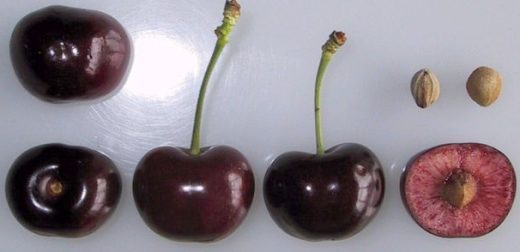VAN CHERRY TREE
It was raised by the Canadian Summerland Research station in British Columbia and released in 1944. It achieved its primary purpose of producing fruit which are resistant to splitting but has been significantly improved on by modern varieties.
Use the checklist below to decide if the Van cherry tree variety is correct for you and your garden. If this is not the correct variety, see our cherry tree varieties page, to select another variety which may suit you better.
- The fruits of Van are produced mid-season, ready for eating, on average, in the third week of July
- Fruits are of medium size. They are bright red and have a sweet and very full flavour. The stones are smaller than average surrounded by lots of cherry flesh.
- The picking period is seven days.
- This variety reliably produces a good amount of fruit.
- Disease resistance is about average and is liable to suffer from canker.
- Van is self-sterile and needs a pollination partner to produce fruit.
- It is fully hardy in all parts of the UK (however, see above about blossom) and a good choice for cooler areas.
WHERE TO BUY VAN CHERRY TREES
Van is not often to be found in your local garden centre but is available online on (almost exclusively) Colt rootstocks. It can be bought as both a potted tree (generally more expensive) all year round or as a bare-rooted tree from October to March (cheaper). We would recommend buying bare-rooted.

Picture from public sector information licensed under the Open Government Licence v2.0.
POLLINATION PARTNERS FOR VAN CHERRY
Van is in pollination group 3, self-sterile and and needs a suitable pollination partner to produce fruit. The following varieties produces blossom at roughly the same time (third week of April) and are suitable for pollinating Van. They are easily obtainable in the UK:
- Merton Glory, pollination group 2, eating variety
- Lapins, pollination group 2 to 3, eating variety
- Penny, pollination group 3 to 4, eating variety
- Summer Sun, pollination group 3 to 4, eating variety
- Stella, pollination group 3 to 4, cooking variety
- Sunburst, pollination group 3 to 4, eating variety
HOW LARGE WILL VAN GROW
On Colt rootstock Van will grow to about 4m / 13ft tall when it has reached maturity after about 7 years. With an annual prune it can easily be kept to 2.4m / 8ft high for a manageable tree in most gardens. On Gisela 5 rootstock it will grow to approximately 2.4m / 8ft.
ALTERNATIVES TO VAN
Click on the box below to see the full range of cherry tree varieties which we have reviewed in detail. Click on any one of them to see the full variety review.
CONDITIONS FOR GROWING VAN CHERRIES
The following are the key rules for growing this variety, click here for more detailed information about growing and pruning cherry trees:
- Plant and grow in a full sun position.
- The best time to plant Van is in late autumn to early winter. It can be planted at other times of year but will require watering more frequently to ensure it establishes well.
- Plant the tree to the same depth as it was in the pot. If planting bare-rooted trees you will see a natural soil mark just above the roots which indicates the correct depth for planting.
- Spread an 8cm / 3in layer of mulch around the base of the tree but not touching the main trunk. A mulched circle of about 1m / 3ft will be sufficient. This will retain moisture in the soil below and greatly help the tree to establish well.
- Water very well immediately after planting.
- Stake the tree for the first two years of its life on a Colt rootstock. If planted on Gisela 5 rootstock the tree will require staking for its life.
- In the first summer after planting the tree, water well if conditions become dry.
- Prune Van in the first year according to the suppliers instructions. Prune annually in later years, soon after the fruit has stopped being produced which will be about the last week of July for Van. See our detailed article on pruning cherry trees.
- An annual mulch in late Spring will help to retain moisture and an even supply of water.
- If any pests or diseases appear treat them as soon as possible. Consult our cherry tree pest and disease page for detailed information on identifying and treating problems.